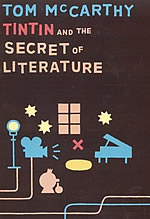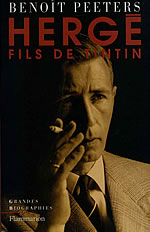Hergé - One Hundred:
The Father Of Tintin
Nearly 100 years after he was born on May 22 1907, Hergé - the Belgian-born father of Tintin - remains a figure who inspires devotion, controversy and, most of all, mystery. Paul Gravett reveals the inside story behind his great creation, and delves into the troubled background and tortured life of a man who changed comics forever.
This is followed by commentaries by Chris Ware, Russell Tovey, Michel Faber and Peter Blegvad, who discuss the importance of Tintin to their lives. Paul Gravett then reviews the new Tintin Character book series by reknowned Tintinologist Michael Farr in a Book Review Extra.
Finally, a Hergé Timeline highlights the notable events during the life and legacy of the Tintin and Snowy creator.
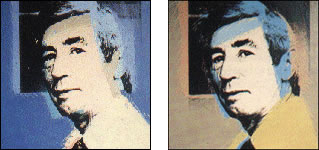
Tintin stares back at millions of men in the mirror every morning. We put a dab of gel in our hair at the front and shape a little quiff to give ourselves an extra bit of bounce and character. Whether or not we realise where this look derives from, we’re actually turning ourselves into the big-hearted boy reporter. It was while Tintin was driving in a high-speed, open-top car chase early on in his debut mission to Russia in 1929 that the roaring wind first ruffled up and blew back his ginger locks. His distinctive tuft has been standing up proud ever since.
Like Magritte and the saxophone, Tintin is a Belgian original, as much Flemish as Francophone in his linguistic and cultural roots, yet with a universal appeal that has been translated into over 50 languages. While Americans chose costumed musclemen with superpowers as their fantasy heroes to save the day, Belgians sent forth a spunky youngster in plus-four trousers with a white fox terrier called Snowy. It’s Tintin’s dot-eyed ordinariness, his almost empty, open-book personality and basic moral humanity that have helped so many readers to imagine themselves in his shoes trotting around the globe (and on the Moon) and righting wrongs.
2007 would have seen the 100th birthday of Tintin’s creator, Hergé - the pen name of Georges Remi from Brussels. His enigmatic alias, pronounced in French as “air-zhay”, was in a way his first great fictional character. He began using it in 1924 to sign his artwork, but he had been called this long before, since his first day in school, because it was popular in Belgian schoolyards at the time to give each other nicknames by reversing your initials. His later choice of it as a nom de plume may well have been a nod to the great Russian-born designer of the period, Erté or Romain de Tirtoff (1892-1990) and a stab at suggesting he had some artistic link to his style.
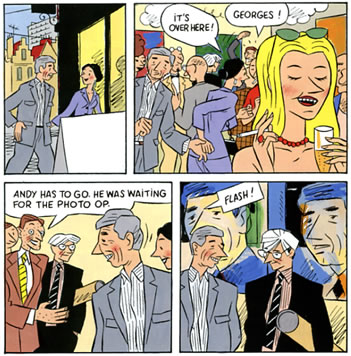
The name Hergé became famous itself, of course, a figure courted by the media, mingling with celebrities and royalty, showered with prizes and plaudits. But behind that media persona, behind the cheerful blank slate of his public appearances and fastidious control of his published interviews, lay an altogether more turbulent, elusive man. Instilled with the morals of strict Catholicism and boy-scouting, Remi had a private life troubled by desires and depressions, and, however unconsciously, these are clearly reflected in his work.
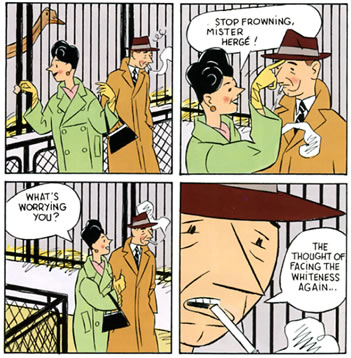
Georges Remi’s background and upbringing had not always been happy. His grandmother had given birth to twins (no, not called Thomson and Thompson), but she never really knew their father. She later married Philippe Remi, a neighbour, who became a “pseudo-father” to the twins until she died in 1901, six years before Georges was born. Philippe, his “pseudo-grandfather”, survived her until 1941 and yet Hergé never met him.
Growing up, he was not close to his younger brother Paul either, and tortured private letters and certain family sources allege that he may have been abused by his uncle, Charles Arthur, 10 years his senior. He once wrote, “Not everyone is lucky enough to be born an orphan.” Later, he was unable to have children, as he had been made sterile accidentally during treatment for boils. It’s no accident that Tintin and the other main characters have no parents, partners, children or close family relationships. Even the Thom(p)sons are not twin brothers; after all, their surnames are different.
Any hints of sexuality are largely absent too from the Tintin books, apart from the unwanted attention Bianca Castafiore gives whisky-loving sea-dog Captain Haddock. As for Hergé, he privately grappled with sexual guilt for years. He admitted that he had quit his first troop of “boy scouts without God” out of disgust at the brawling and group masturbation into which older boys lured their juniors. What would Baden-Powell have said? He married the boss’s secretary, Germaine Kieckens, while still young, and hardly kept secret from her at least two post-war affairs with younger women; this culminated in a third with a vivacious studio colourist called Fanny Vlamynck, who was 27 years his junior and for whom he eventually left his wife. Although they separated in 1960, he and Germaine kept up appearances in public for 17 years, until they were finally divorced and he remarried Vlamynck.
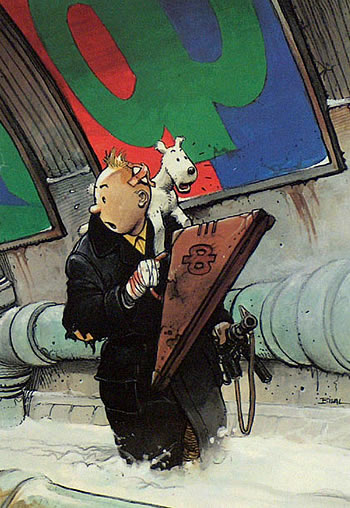
Tintin & Snowy by Enki Bilal
Without doubt the single most notorious and hoary question mark that has hovered over Hergé‘s head, exactly as they do over his characters’ heads in many of his panels, is whether or not he collaborated and sympathised with the Nazis during their occupation of Belgium. This claim was based on the fact that he continued to create Tintin strips, never pro-German in tone, for the evening paper Le Soir, despite the fact that under Nazi control it had became a mouthpiece for anti-Semitic propaganda. Amid the tensions and arrests of some 600,000 people after the liberation of Brussels in 1944, he was arrested four times, and spent a night in prison. Several of his colleagues in similar positions were charged and jailed, or lost their rights and livelihoods. One, Paul Herten, was executed. Hergé was never formally charged but had to live with that threat and a sense of people’s disapproval while being forced to weather a two-year exile from the press.
The banal but likely truth is that, though unwise with hindsight, he was driven mostly by business sense, not politics, because he knew Tintin would help sell more newspapers, which in turn would help sell more Tintin books. His efforts to remain neutral backfired.
He had to wait until 1946 to be redeemed in the public eye by Raymond Leblanc, a former resistance fighter. Leblanc put Hergé in charge of a new weekly Tintin magazine and in exchange got Hergé his “certificat de civisme”, official papers that gave him a new lease of life.
Nevertheless, Hergé‘s correspondence and journals reveal how those accusations cast long shadows and prompted 15 years of nervous depression. Even today, after the charges were debated in the French National Assembly, and methodically laid to rest in Pierre Assouline’s 1996 biography of Hergé, their taint seems to resist being wiped clean entirely.
Tintin came to life in 1929, when Hergé was only 21, serialised in weekly episodes for Catholic newspaper Le Vingtième Siècle (The Twentieth Century). He drew one panel of the Gare du Nord station in Brussels being mobbed by crowds of readers welcoming Tintin and Snowy back from their Russian assignment in 1930. He must have been struck by just how much he was connecting to his readers when, after a promotion in the paper, a real crowd of thousands flocked to meet him and a young actor playing Tintin at that very same station. These were more innocent, in fact naïve times, when he was content to go along with the firm political agendas of his boss Abbot Wallez. In his first two tales - Tintin In The Land Of The Soviets and Tintin In The Congo - he would mock the Bolshevik Revolution, show animal life as expendable and portray Africans as simpletons, with Tintin as the White Man bringing “civilisation”.
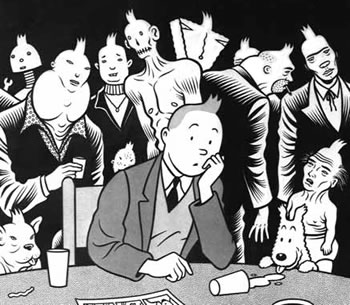
Tintin & Snowy by Charles Burns
A key turning point in Hergé‘s maturity and the formation of his own political views took place on Sunday 1 May, 1934. At 5pm precisely, Chang Chong-jen rang the doorbell at his flat. His guest for tea was four months his junior, a gifted Chinese student of painting and sculpture in Brussels, and they became instant and lifelong friends. Chang’s initial mission was to letter calligraphy and advise him on the fifth Tintin adventure, The Blue Lotus, to be set in China, but this blossomed into something deeper. The two of them met on many Sunday afternoons for over a year. China was then suffering the invasion by the Japanese and Chang encouraged Hergé to depart from the broad stereotypes, cultural clichés and largely unplanned spontaneity of his first four books and strive for a greater realism. Hergé put Chang into the story as a younger boy who is saved and befriended by Tintin. Hergé recalled: “It was from that time I undertook research and really interested myself in the people and countries to which I sent Tintin, out of a sense of responsibility to my readers.” When Japanese diplomats complained about the powerfully pro-Chinese message of The Blue Lotus, Hergé refused to back down and change anything.
Herge’s sensibilities may have been changing, but he was no happier personally. By 1947, the mounting success and demands of his cartoon character were starting to stir feelings of rebellion and resignation. During an exchange of emotionally honest letters with his first wife Germaine, disclosed in Benoît Peeters’s remarkable 2002 biography, Hergé: Fils de Tintin (Son Of Tintin), Hergé admitted to feeling hemmed in by his morally perfect creation: “I have just discovered that I know Tintin is no longer me; that if he is to go on living, it will be by a sort of artificial respiration that I will have to practise constantly and which exhausts me, and will exhaust me more and more.”
Through the 1950s, the pressures of the blank page, of his adultery with Fanny and of losing touch with perhaps his closest friend Chang (who had returned to China) resulted in his most emotionally charged story, Tintin In Tibet. It is many people’s favourite, including Hergé‘s. It’s perhaps the only one where the boy reporter really shows his feelings, where he (omega) cries in anguish, anger and joy. His search for the missing Chang in the Himalayas mirrors Hergé‘s own separation from the real Chang. (Like the book, there was a happy ending when the two were reunited in 1981.)
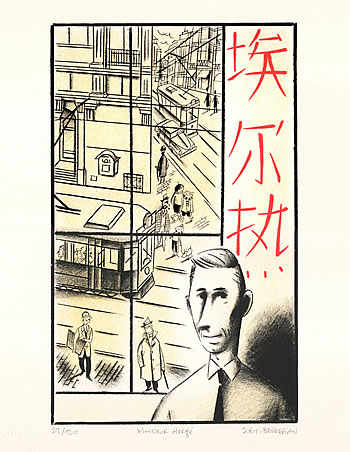
Hergé by Dupuy & Berberain
The anodyne analogy Hergé fostered is that he was Tintin’s father. Peeters’s biography suggests this rings false and the reverse is true: Hergé was in fact the son of Tintin, because without creating his adventures, without the research and discoveries they required, the meetings with vital influences and mentors, Hergé himself might never have evolved and matured. Peeters’s view is that “The Adventures of Tintin constitute an indirect autobiography, a sort of journal through which can be read all the events, public or private, which marked Georges Remi. But in this singular ‘coming of age’ novel, above all it’s the character who constructs his author.”
After Hergé‘s death in 1983, it could have been so easy for Tintin to fade away too, especially as Hergé insisted no further exploits could be created by other hands. Unlike corporate-owned characters such as Superman, endlessly revamped by new hired hands, Tintin is one person’s self-expression. As he once said, “Tintin is me and we will disappear together!” In fact, he left one last unfinished album, Tintin & Alph-Art, a satirical romp through the worlds of conceptual art, forgers and fake gurus. For a while, hopes were high that his trusted assistants would be allowed to convert his sketches and notes into a full-length story. His widow Fanny, however, insisted her husband’s wishes be respected.
There it might have ended. Far from disappearing, though, Tintin has flourished. Fanny and her new husband Nick Rodwell, a dynamic Brit, have consolidated and promoted the legacy and brand within the new Moulinsart enterprise (the French name for Captain Haddock’s ancestral home, Marlinspike). Not everyone may have warmed to this zeal and vision, but the boy and his dog are thriving through a panoply of books, merchandise, animated adaptations, documentaries, touring exhibits and other tie-ins.
Above all, these varied spin-offs should send the public back to read or re-read Hergé‘s perennially popular 23 adventures, and his 24th, the incomplete swansong Alph-Art, which in the end was released in its outline form. This core oeuvre is such a multi-faceted source, that it has roused those in the rarefied fields of Tintinology, Tintinophilia, Tintinolatry, Tintinadulation - call it what you will - to feverish industry. No comic creator, and no comic character anywhere in the world, has inspired so many books about them as these two Belgian institutions. This ever-expanding library ranges from exhaustive train-spotting to penetrative biographical investigation, from a dictionary of Haddock’s explosive expletives to a series of doorstop-sized catalogues raisonnés of his entire graphic output. Of several lit-crit analyses, the first in Britain was penned this year by novelist Tom McCarthy as his playful, insightful Tintin & The Secret Of Literature from Granta Books.
Hergé‘s centenary year of celebrations kicks off early with the opening on 19 December 2006 of an unmissable exhibition co-curated by Nick Rodwell at the Centre Pompidou, with free admission to celebrate the Paris landmark’s 30th anniversary. Out of the archives held by the Fondation Hergé have emerged hundreds of drawings, original pages of artwork, letters, photos, sound recordings and printed materials. While this will chart Hergé‘s public life and work closely, some of the more intimate struggles of Georges Remi may not be addressed. But it is telling that out of all his output, the one Tintin album that is presented here in its entirety is the first black-and-white version of The Blue Lotus. This was not only the turning point in his creative career and moral outlook, but in the course of the world history of the comics medium. It is also a record of his most long-lasting and meaningful friendship that spanned many years and two cultures.
TINTIN & ME
Tintin & Me: Chris Ware
Chris Ware is the author of ‘Jimmy Corrigan’ and ‘The Acme Novelty Library’. The following comments by Chris Ware first appeared as part of a PBS Point Of View Special - ‘On Cartooning.
Tintin was fundamentally too sexless to really catch on in America. There are hardly any girls in Hergé‘s stories, and there’s also a peculiar sense of responsibility and respect in Tintin that is antithetical to the American character, or at least that of the budding individualist nine-year-old boy who just wants to set things on fire and has been weaned on much more outrageous stories. I’m not even sure if it’s fair to say that there is an analog in American culture to Tintin, actually.
I read a few serialised episodes in a magazine my mom subscribed to for me when I was a kid and it made me feel really, really weird; I didn’t like it at all. I could tell that it was “approved” and “safe” and it immediately bored me, because it didn’t seem to have anything to do with what I thought of as the “real” adult world, which was for me at that time superpowers and crimefighting. (I like Tintin now, of course.)
Incidentally I stole the idea of using very carefully composed naturalistic colour under a platonic black line more or less directly from Hergé, as there’s a certain lushness and jewel-like quality to his pages that also hints at the way we gift-wrap our experiences as memories.
Tintin & Me: Russell Tovey
Russell Tovey was most recently seen as Rudge in ‘The History Boys’.
I always loved Tintin, from about 10 years old, when I bought a couple of old books at a bring-and-buy sale (I still have them). I went to France in the first year of senior school and he was everywhere. I got a bit obsessed, mainly because of the artwork - I’ve always been a massive Pop Art fan. I ended up buying erasers and rulers and anything with his image on it.
I was really daunted before playing him in the Young Vic’s production of Tintin In Tibet last year - how do I bring to life a character that has been in people’s hearts for decades and who they have projected their own personality on? In the end we decided to keep my natural accent - I’m from Essex - and I’m really pleased we did. I’m not sure that most people would imagine Tintin as Cockney, but it felt like I had my own personal mark on the character. I loved playing him, just because of the audiences of kids who looked at you as if you were a hero, reminding me of going to Disney World on my birthday as a child and meeting Mickey Mouse.
Tintin & Me: Michel Faber
Michel Faber‘s most recent book is ‘The Apple’.
I first read Hergé‘s Destination Moon and Explorers On The Moon in a state of deep historical and personal confusion. I was nine; the year was 1969. I’d recently emigrated to Australia from my native Holland . As well as leaving my brother behind, I’d been parted from all my familiar comic book characters. Sjors and Sjimmie, Ollie B. Bommel, Agent 327… these names meant nothing to my Antipodean playmates. Still, at least there was Kuifje. Even Australians knew Kuifje: the intrepid teenage explorer with his dog Bobbie and his dear friend Kapitein Haddock. Except they didn’t call him Kuifje (a Dutch nickname denoting a duck-tail hairstyle), they called him Tintin.
My first encounters with The-Adventurer-Formerly-Known-As-Kuifje were those two extraordinary, prophetic spaceflight books which Hergé produced in 1953 and 1954, fifteen years before the real moon landing. Except I didn’t know that, either. The books were brand new when my parents bought them for me in 1969. I thought Hergé had just written them to capitalise on the excitement surrounding the Apollo mission. Neil Armstrong had gone to the moon (I’d seen the newspaper photographs to prove it), and now Tintin and his pals were doing it their way. The Americans struck me as a solemn bunch, apparently in awe of their own technology, moving in slow motion. Tintin was sprightly as ever. His moon mission was an action-packed ballet of pratfalls and fisticuffs. Re-reading the two books now, I can reconnect with the original thrill as Tintin, dressed in his bulky orange spacesuit, torchlight beaming from his chest, lets himself fall into a vast lunar cavern, muttering "Into the hands of fate!"
As a child, I never noticed how vacant a personality Tintin was. Unfailingly practical, coolly plucky, and 100% free of vices, he tackled his adventures as though they were bicycle repairs. Hergé understood the narrative shortcomings of his hero, of course, and surrounded him with wonderfully dysfunctional grotesques. On the moon mission, not only did the dipsomaniac Captain Haddock and the dippy Professor Calculus come along, but there were bonus stowaways: the imbecilic detectives Thomson & Thompson, and a dastardly Syldavian spy. Hergé even added a touch of psychedelia, as the stress of space travel triggered a relapse of a syndrome from which the Thom(p)sons periodically suffered – the sprouting of thick, multicoloured hair that grows at several metres per minute and thus needs constant barbering.
For all the knockabout fun in Destination Moon and Explorers On The Moon, Hergé constructed them with obsessive care, researching space travel as diligently as he researched the different countries to which he sent Tintin over the decades. But that’s not what makes the books undiminishedly enjoyable even for an adult re-reader. Prose like Enid Blyton’s loses its appeal because the mental pictures we supplied as children vanish when we grow older. The pictures in Hergé‘s books continue to exist outside of us. His clear, deft style, perfectly balanced between kinetic cartoon and realistic detail, retains its allure as the years fly by.
Tintin & Me: Peter Blegvad
Peter Blegvad is the author of ‘The Book of Leviathan’.
Hergé was one of the most successful products of Lord Baden-Powell’s “Character Factory”: the Boy Scout movement (Belgian branch). Hergé himself was a character factory of genius. His most successful product, while ostensibly a professional journalist, is an undercover “Eagle Scout” (or whatever the Belgian equivalent is for the top perch on the Boy Scout totem-pole) - an amateur polymath who exemplifies the motto “Be Prepared.” The same could be said for his creator whose near mania for preparatory research is perhaps an expression of the fidelity his grounding in Scout culture inculcated. Faithfulness to phenomena as an expression of reverence for the creator of all things. The treatment he lavishes on depictions of a DC-7, a bottle of wine, the surface of the moon, etc. is so painstaking that it strikes me as penitential.
I met Hergé once. Stood in a long queue in Hamley’s on Regent Street in the late 1960s when he was over here promoting publication of Flight 714. I asked him to inscribe two copies, one to me and the other to “Prince Billy of Hommedrole”. Before inscribing the latter he looked up at me and words were exchanged, but I don’t remember anything we said. While unfaithful in plenty of other spheres, my conviction, formed when I was 13 or so, that books like The Secret Of The Unicorn and Red Rackham’s Treasure are “perfect works of art” has not wavered in 45 years.
REVIEW EXTRA:
Tintin Character Series
by Michael Farr
Egmont Publishing
£6.99 each
Cannily coinciding with this coming week’s centennial celebrations, British Tintinologist extraordinaire Michael Farr has had the inspired idea of examining six of Hergé‘s iconic figures (or seven, including one dog) in a new series of attractive square-format 48-page hardbacks, originally designed and published by Moulinsart in Belgium and issued here by Egmont Publishing. These character studies of Tintin, Snowy, Captain Haddock, Thomson & Thompson, Professor Calculus and Biana Castafiore survey their origins and creation, and the development of their personalities and relationships to each other as revealed through the 24 albums, the last left unfinished. Farr strikes an astute balance between accessibility to the general reader and more specialist insights for true Tintinophiles. He peppers his lively, fairly concise essays, typeset large and spaced, with choice quotes from Hergé and fascinating anecdotes and observations.
For example, it’s intriguing to learn that there are missing boyhood drawings from Georges Remi’s school exercise books during World War 1 of a Tintin prototype, a Belgian boy battling those beastly Germans or Boches occupying Brussels. Imagine if those were miraculously rediscovered? Ever wondered how old Tintin is? It seems Hergé based him to a great extent on his brother Paul, down to his quiff, who at age 16 was five years younger than him. Later Hergé suggested that Tintin was “14 or 15 when I created him” and “put on 3 or 4 years in 40 years”, making him 19 by 1970. As for his name, Tintin is actually his surname, and we never learn his first name. Farr also refers to the scientific study by a Canadian professor who theorises that the repeated blows to Tintin’s head and other losses of consciousness, some 50 in all, may account for a “growth hormone deficiency… This could explain his delayed statural growth, delayed onset of puberty and lack of libido.”
Snowy’s secrets revealed include his initial inspiration being in part the fox terrier owned by the landlord of the café-restaurant frequented by Hergé and others from the newspaper staff. In fact, that same dog played Snowy in a publicity stunt with an actor dressed up like Tintin at the Brussels Gare du Nord station on the duo’s return from Soviet Russia. Snowy’s French name Milou comes from the diminutive name of Hergé‘s first serious girlfriend, but Farr assures us, have no fear, Snowy is definitely a male of the species, not just from his character and actions, but from being called “il” (he) in the original French versions.
Captain Haddock boisterous vigour derived partly from Edgar-Pierre Jacobs, who was Hergé‘s first great assistant on the stories, former opera singer and author of the classic Blake and Mortimer series. It is uncanny how Haddock turned out to have a genuine distinguished ancestor, a Sir Richard Haddock (1629-1715) whose portrait is shown here. Another source was the 1933 musical film Captain Craddock. Haddock’s smart wardrobe at Marlinspike reflects Hergé‘s own dress sense, born from his father’s business running a boys’ outfitters shop, while the sea dog’s repertoire of expletives tops two hundred. Farr reveals a recently unearthed sketch from the incomplete Tintin & Alph-Art showing the captain transformed into a trendy art groupie “with hair falling below his shoulders, John Lennon-style wire-rimmed glasses, flared and studded jeans, boldly patterned top, broad belt and handbag.” Mercifully perhaps, this eccentric make-over never made it into Hergé‘s final storyline draft.
In each book Farr also offers intriguing photos, artifacts and preparatory pencil drawings, concluding with a four-page sketchbook supplement. The books’ design is crisp and elegant, down to the choice of symbolic image on their title page: for example, Tintin’s quiff surrounded by stars and “squeens” as he is knocked out again; Snowy’s one-track mind in a speech balloon of a glorious bone; or Haddock’s jagged black balloon of furious death threats represented by a skull and crossbones, gun, knife, poison bottle and featherless, plucked parrot. As well as the first six stars, the back cover shows a full dozen characters, including Tintin’s Chinese friend Chang and his arch-nemesis, rascally Greek-American tycoon Rastapopoulos - let’s hope candidates for further books in this attractive series.
HERGÉ TIMELINE
1907:
22 May, born Georges Prosper Remi in Etterbeek, Brussels.
1923:
Starts illustrating for Le Boy-Scout.
1924:
Coins pseudonym Hergé (his initials G.R. in French and in reverse).
1925:
Hired by Belgian Catholic newspaper Le Vingtième Siècle (The Twentieth Century).
1929:
10 January, Tintin and Snowy debut in the paper’s children’s section.
1930
Tintin In The Land Of Soviets first published in book form.
1932:
Marries Germaine Kieckens.
1934:
Meets life-chaniging Chinese student Tchang Tchong-jen.
1940:
Le Vingtième Siècle closes down and Hergé sent home from the army for health reasons.
1940:
17 October, Tintin returns in a new story in evening paper Le Soir.
1942:
Publishers Casterman ask Hergé to adapt his stories into the familiar 64-page colour format.
1944:
Belgium liberated, Hergé arrested, questioned but never charged.
1946:
Weekly Tintin magazine begins.
1950:
Hergé starts the Hergé Studios to assist him with Explorers On The Moon.
1951:
Tintin first appears in English in the weekly comic Eagle.
1956:
Hergé begins secret relationship with Studios colourist Fanny
Vlamynck.
1956:
First animated Tintin TV series.
1958:
Hergé‘s creative pressures and private life reach crisis point.
1960:
Hergé leaves his wife and moves in with Fanny.
1961:
First live-action Tintin movie.
1969:
First full-length animated Tintin movie.
1971:
First trip to the USA.
1973:
Hergé allows an archival edition of Tintin’s first Soviets story.
1976:
Hergé and Tchang Tchong-Jen are reunited.
1977:
Hergé marries Fanny.
1979:
Warhol makes 4 portraits of Hergé.
1983:
3 March, Hergé dies.
Steven Spielberg acquires the rights till 1988 to make a live-action Tintin film.
1984:
The Tintin Shop opens in Covent Garden, London.
1986:
Last unfinished adventure, Tintin & Alph-Art, is published.
1989:
60th anniversary Tintin exhibition at Chelsea Town Hall, London.
1990:
Fanny Remi and British businessman Nick Rodwell set up Moulinsart to manage the enterprise.
1991:
21 Tintin adventures, all of them except the first two, are newly animated for television.
1994:
Hergé‘s widow marries Nick Rodwell.
2002:
Steven Spielberg announces further plans to make a new Tintin movie.
2004:
Tintin’s 75th birthday sees record attendances at the National Maritime Museum’s Tintin At Sea exhibition and plans for a Hergé Museum in
Louvain, near Brussels.
2005:
First Tintin Festival in Brussels and Tintin In Tibet musical opens at London’s Barbican Theatre.
2006:
Centenary celebrations kick off with exhibition at the Centre Pompidou, Paris.
2007:
15 May, Steven Spielberg and Peter Jackson announce a series of motion picture
films based on the adventures of Tintin.
22 May, the 100th anniversary of the birth of Hergé.
22 May, the foundation stone is laid for a new Hergé Museum at Louvain-La-Neuve, 20 kilometres (12 miles) from Brussels.
Posted: May 20, 2007The original version of this article appeared in The Independent On Sunday on 10 December, 2006. With thanks to Chris Ware, Russell Tovey, Michel Faber and Peter Blegvad for permission to reprint their comments.














